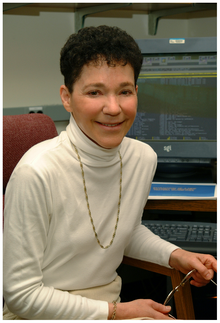Ruth Nussinov | |
|---|---|
 | |
| Alma mater | University of Washington, Rutgers University |
| Known for | Nucleic acid structure prediction, PLoS Computational Biology, Nussinov plots, Equilibrium unfolding, Protein–protein interaction prediction, Dynamic conformations determine protein function and cell phenotype, Conformational selection and population shift, Dynamic allostery, Current Opinion in Structural Biology |
| Awards | |
| Scientific career | |
| Fields | Bioinformatics, Computational structural biology, Biophysics |
| Institutions | Weizmann Institute, Berkeley, Harvard, Tel Aviv University, NCI |
| Thesis | Secondary structure analysis of nucleic acids (1977) |
| Website | http://ccr.cancer.gov/staff/staff.asp?profileid=6892 |
Ruth Nussinov (Hebrew: פרופסורית רותי נוסינוב) is an Israeli-American biologist born in Rehovot who works as a professor in the Department of Human Genetics, School of Medicine at Tel Aviv University and is the senior principal scientist and principal investigator at the National Cancer Institute, National Institutes of Health.[1] Nussinov is also the editor in chief of the Current Opinion in Structural Biology and formerly of the journal PLOS Computational Biology.[2][3]
In 1978, Nussinov proposed the first dynamic programming approach for nucleic acid secondary structure prediction, this method is now known as the Nussinov algorithm.[4][5]
Her most important discovery was in the 1990s. In 1999 Nussinov published the transformational concept that all conformations preexist—even if the crystal captures only one—and that evolution harnesses their dynamic interconversion for function, dispelling the dogma that only the wild-type shape is relevant.[6][7][8][9] Nussinov suggested a vastly different scenario from the-then dogma of two, “open” and “closed" conformations proposed by Monod, Wyman, and Changeux. She proposed that there is not one folded form, nor two—as they suggested—but many different forms, and in equilibrium, the system keeps jumping between them, and that this barrier-crossing is function. The concept that she suggested is significant since it explained that rather than the ligand inducing a conformational change (as in induced fit), the ligand can select a preexisting (relatively rare, non-minimal energy) conformation in the system that may be better suited to dock it, with minor optimization. It will then bind the ligand, and the equilibrium will keep producing more of this conformation to compensate, which she suggested (also in 1999), is the allosteric effect. This foundational “conformational selection and population shift” idea as an alternative to the “induced fit” text-book model explains the mechanism of molecular recognition. The dynamic shifts among conformations explain catalysis (2000), regulation, kinase activation, and allosteric drugs actions.[9] Her concept was confirmed by innumerable experiments and is now widely established. As Nussinov and others have shown since, this paradigm helps unravel diverse processes as signaling, regulation, and aggregation in amyloid diseases, and oncogenic transformation, contributing to extraordinary advancements in understanding structure and function.[10]
Nussinov has authored over 750 scientific papers with nearing 80,000 citations in Google Scholar, and has given hundreds of invited talks.[11][12] Most recently, she pioneered the connection, on the structural and cellular levels, of cancer and neurodevelopmental disorders asking How can same-gene mutations promote both cancer and developmental disorders?.[13]
A personal scientific overview of her biography has been published in 2018 as “Autobiography of Ruth Nussinov”.[14]
- ^ "Tel Aviv University Experts Page". Retrieved July 27, 2023.
- ^ "Current Opinion in Structural Biology - Editorial Board". Retrieved July 27, 2023.
- ^ Nussinov, Ruth (2013). "How Can PLoS Computational Biology help the biological sciences?". PLOS Computational Biology. 9 (10): e1003262. Bibcode:2013PLSCB...9E3262N. doi:10.1371/journal.pcbi.1003262. ISSN 1553-7358. PMC 3789778. PMID 24098104.
- ^ Nussinov, Ruth; Pieczenik, George; Griggs, Jerrold R.; Kleitman, Daniel J. (1 July 1978). "Algorithms for Loop Matchings". SIAM Journal on Applied Mathematics. 35 (1): 68–82. doi:10.1137/0135006.
- ^ Nussinov, R; Jacobson, AB (Nov 1980). "Fast algorithm for predicting the secondary structure of single-stranded RNA". Proceedings of the National Academy of Sciences of the United States of America. 77 (11): 6309–6313. Bibcode:1980PNAS...77.6309N. doi:10.1073/pnas.77.11.6309. PMC 350273. PMID 6161375.
- ^ Tsai, Chung-Jung; Kumar, Sandeep; Ma, Buyong; Nussinov, Ruth (1999). "Folding funnels, binding funnels, and protein function". Protein Science. 8 (6): 1181–1190. doi:10.1110/ps.8.6.1181. PMC 2144348. PMID 10386868.
- ^ Ma, Buyong; Kumar, Sandeep; Tsai, Chung-Jung; Nussinov, Ruth (September 1999). "Folding funnels and binding mechanisms". Protein Engineering, Design and Selection. 12 (9): 713–720. doi:10.1093/protein/12.9.713. ISSN 1741-0134. PMID 10506280.
- ^ Tsai, Chung-Jung; Ma, Buyong; Nussinov, Ruth (1999-08-31). "Folding and binding cascades: Shifts in energy landscapes". Proceedings of the National Academy of Sciences. 96 (18): 9970–9972. Bibcode:1999PNAS...96.9970T. doi:10.1073/pnas.96.18.9970. ISSN 0027-8424. PMC 33715. PMID 10468538.
- ^ a b Kumar, Sandeep; Ma, Buyong; Tsai, Chung-Jung; Sinha, Neeti; Nussinov, Ruth (2008-12-31). "Folding and binding cascades: Dynamic landscapes and population shifts". Protein Science. 9 (1): 10–19. doi:10.1110/ps.9.1.10. PMC 2144430. PMID 10739242.
- ^ Ma, Buyong; Kumar, Sandeep; Tsai, Chung-Jung; Hu, Zengjian; Nussinov, Ruth (April 2000). "Transition-state Ensemble in Enzyme Catalysis: Possibility, Reality, or Necessity?". Journal of Theoretical Biology. 203 (4): 383–397. Bibcode:2000JThBi.203..383M. doi:10.1006/jtbi.2000.1097. PMID 10736215.
- ^ "Google Scholar Author Profile". Retrieved August 19, 2024.
- ^ "Ruth Nussinov - Curriculum Vitae - February 2023" (PDF). Archived from the original (PDF) on July 25, 2023. Retrieved July 27, 2023.
- ^ Nussinov, Ruth; Tsai, Chung-Jung; Jang, Hyunbum (2022-01-14). "How can same-gene mutations promote both cancer and developmental disorders?". Science Advances. 8 (2): eabm2059. Bibcode:2022SciA....8.2059N. doi:10.1126/sciadv.abm2059. ISSN 2375-2548. PMC 8759737. PMID 35030014.
- ^ Nussinov, Ruth (2021-07-01). "Autobiography of Ruth Nussinov". The Journal of Physical Chemistry B. 125 (25): 6735–6739. doi:10.1021/acs.jpcb.1c04719. ISSN 1520-6106. PMID 34192875. S2CID 235696300.
